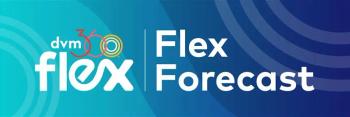
Hot topics from the 16th annual IVECC symposium (Proceedings)
The clinical utility of ultrasonography in the emergency room has been expanding in recent years. Two techniques recently presented are known as abdominal focused assessment with sonogram for trauma (AFAST) and thoracic focused assessment with sonogram for trauma (TFAST).
AFAST/TFAST
The clinical utility of ultrasonography in the emergency room has been expanding in recent years. Two techniques recently presented are known as abdominal focused assessment with sonogram for trauma (AFAST) and thoracic focused assessment with sonogram for trauma (TFAST). The combined use of AFAST and TFAST provides a rapid assessment of four spaces (abdominal, retroperitoneal, pleural, pericardial). Examinations are typically performed in the absence of shaving hair.
The AFAST examination has been evaluated with patients in right lateral recumbency, with the following four sites: 1) Diaphragmatic-Hepatic (DH) view, also used to image the pleural and pericardial spaces; 2) Spleno-Renal (SR) view, also used as a window into the retroperitoneal space; 3) Cysto-Colic (CC) view; 4) Hepato-Renal view is a favorable site for abdominocentesis.
An abdominal fluid scoring (AFS) system has been shown helpful in predicting severity of hemorrhage, and corresponding with the patient's need for blood transfusion.
• AFS 0 - negative at all four sites
• AFS 4 - positive at all four sites
• AFS 1,2 - positive at one to two sites (DH & CC most common), patients rarely become
• anemic from intra-abdominal hemorrhage
• AFS 3,4 - positive at three to four sites, patients often become anemic, with 25% becoming severely anemic (<25%) warranting blood transfusions and rarely emergent laparotomy.
The TFAST examination consists of five sites: 1) Chest tube site (CTS) view, performed bilaterally; 2) Pericardial site (PCS) view, performed bilaterally; 3) Diaphragmatic-Hepatic (DH) view previously highlighted as part of the AFAST exam. The CTS is best for ruling out a pneumothorax (PTX), as well as surveying for lung pathology. The PCS view is best used to evaluate for the presence of pleural or pericardial fluid. This view may also be used to assess volume status via the left ventricular short axis view, as well as "quick peaks" of the left atrial:aortic (LA:Ao) ratio to rule out left-sided heart failure.
Echocardiography and measurement of intravascular volume
As a supplement to traditional techniques used to assess intravascular volume status (heart rate, mucous membrane color and capillary refill time, blood pressure, jugular vein observation and central venous pressure, blood lactate, urine specific gravity and urine output), echocardiography may provide additional information to provide the most accurate assessment of an individual's volume status.
Dilated hepatic veins
Hepatic veins are often distended in patients with chronic fluid overload conditions. When seen in association with ascites, most cases of ascites will be due to a cardiac cause or an obstruction to venous return.
Left atrial size
In the vast majority of dogs and cats with left-sided congestive heart failure, there will be moderate to marked left atrial enlargement present on echocardiogram. Hypovolemia often results in a small left atrium and "triangulation" of the appearance of the left atrium.
Ventricular size and volume
Animals with hypovolemia often have small right and left ventricular internal dimension in diastole and systole, thickening of the walls of the left ventricle and interventricular septum (pseudohypertrophy), and a small pulmonary artery size (unless pulmonary hypertension and/or pulmonary embolism cause the left heart findings). Relatively normal cardiac size means that additional fluids can be given, but that large volume fluid administration is unlikely to help. If cardiac cavity dimensions are increased (specifically LA and LV cavity size) then fluid therapy might result in fluid overload or pulmonary edema, and other approaches to improve blood pressure (vasopressor) or cardiac performance (inotropes) should be considered. Also, cardiac performance can be assessed and reduced contractile function, if present, can provide evidence in support for need for an inotropic agent. Typically, all cardiac chambers are enlarged in cases of fluid overload. The enlargement of cardiac chambers is usually modest, although LV fractional shortening may be slightly reduced in animals with sepsis.
Intravenous lipid emulsion (ivle) therapy for selected toxicoses
Interest in intravenous lipid emulsion therapy, which was first shown to be an effective treatment for local anesthetic toxicity, has grown as a novel antidote for a wide spectrum of drugs class toxicities, such as beta-blockers, calcium channel blockers, parasiticides (ivermectin), herbicides and several varieties of psychotropic agents. All of these medications are similar in that they are highly lipophilic agents. Although the precise mechanism of action is unknown, the most widely accepted hypothesis is that the infused lipid acts as a "lipid sink", absorbing the toxin.
Intravenous lipid emulsions are typically used as a dense source of calories in patients receiving parenteral nutrition admixtures. With a tonicity of 600-900 mOsm/L, IVLE is well tolerated when short-term administration occurs through peripheral catheters. While safety studies are promising, reported adverse events observed are hypersensitivity reactions to the egg stabilizer, thrombophlebitis, and pancreatitis, while it remains unclear if interference occurs with other administered medications. Several brands are available, such as Intralipid® (Baxter Pharmaceuticals), Liposyn® (Hospira Pharmaceuticals), Medialipid® (Braun Pharmaceuticals).
While there are limited case reports (cite source) and anecdotal reports of use in veterinary medicine, much of the initial studies in human medicine have been performed in animal toxicology studies. Information from the developer of the technique, Guy Weinberg, suggests the following supplies be on hand for IVLE therapy:
• 500 ml Intravenous lipid product
• IV tubing
• Three, 60 ml syringes
• Several 18 G needles
• A print out of the LipidRescue© instructions
The standard dosing protocol using the 20% formulation of IVLE is 1.5 ml/kg over 5-15 minutes, then 0.25 mg/kg/min over 1-2 hours. This dose can be repeated in several hours if clinical signs of toxicity return. Prior to repeating the dose, a peripheral blood sample should be evaluated for evidence of lipemia; additional doses should not be given if lipemia is present. As the IVLE suspension is susceptible to bacterial growth, aseptic technique is required. Consultation with a professional animal poison control agent is advised, as are other indicated supportive measures (IV fluid therapy, oxygen supplementation, mechanical ventilation, etc.).
Your cat ate what? Newer intoxications
Acetaminophen
Cimetidine, an inhibitor of cytochrome P-450s, traditionally has been recommended in treating toxicoses. It has now been demonstrated that cimetidine blocks one of the only pathways that cats have to convert methemoglobin back to hemoglobin.
Ethylene glycol
Cats are much more sensitive to ethylene glycol, than dogs are. The PRN test is not sensitive enough for cats. The Kacey strip test and the React test are sensitive enough for cats but have many false positive results. The most reliable means of a diagnosis is having an ethylene glycol level run at a human hospital on a STAT basis.
Fomepizole has been approved for use in dogs only. At dosages used in dogs, fomepizole is ineffective in treating feline toxicosis. Cats require much higher doses (125 mg/kg, then 31.24 mg/kg at 12, 24 and 36 hours). Unfortunately, this regimen was only successful if initiated within 3 hours of ingestion.
Venlafaxine
Venlafaxine (Effexor®) is a bicyclic antidepressant with potent serotonin and norepinephrine reuptake inhibition and weak dopamine reuptake inhibitory effects. Available in either an immediate release or and extended release form. Cats seem to readily eat venlafaxine and display serotonin syndrome signs (mydriasis, vomiting, tachypnea, tachycardia, ataxia and agitation) at doses as low as 2-3 mg/kg.
Treatment consists of emesis in asymptomatic individuals, followed by activated charcoal, with repeat doses in 4-6 hours if an extended-release formulation was involved. With ingestion of the latter, cats can be symptomatic for up to 72 hours. Acepromazine may be administered for agitation and cyproheptadine to antagonize serotonin effects. Intravenous lipid therapy can be used to decrease plasma levels and decrease treatment time. Venlafaxine will cause a false positive reaction for PCP on the OTC urine drug tests.
Vyvanse®
Vyvanse® (lisdexamphetamine), a prodrug of dexamphetamine, is a newer medication used to treat ADHD in children. Amphetamines stimulate both alpha- and beta-adrenergic receptors, causing release of endogenous catecholamines.
Vyvanse® is an extended release medication and signs may be delayed for several hours, lasting up to 72 hours. The most common clinical signs in cats include hyperactivity, tremors, tachypnea, and hyperthermia, while less common signs consist of tachycardia, vomiting, diarrhea, hypertension and seizures.
Treatment consists of emesis, followed by activated charcoal. Fluid therapy is indicated to enhance elimination. Agitation and hyperactivity are best treated with phenothiazines. Diazepam can worsen dysphoria. Cyproheptadine has been used as some of the CNS effects are related to serotonin excess. If tachycardia persists despite institution of sedation, cyproheptadine and intravenous fluid therapy, beta blockers may be used.
Drug interactions in the icu
The intensive care unit (ICU) can be seen as the land of polypharmacy. In this setting, the potential for drug-drug interactions (DDI) is immense, placing critically ill patients at risk for experiencing complications secondary to these unintended interactions. These interactions may manifest as altered absorption, distribution, metabolism and/or elimination of other drugs. These alterations may culminate in toxicity, through increased activity, or decreased efficacy and possible treatment failure. To further complicate matters, certain pathologic conditions that are not uncommon in ICU patients, such as hypoalbuminemia, increased volumes of distribution (from edema), altered perfusion and organ failure(s), can alter pharmacologic response(s). Specific interactions:
Metoclopramide & dopamine
Dopamine is a synthetic catecholamine that may be used to achieve various, dose-dependent therapeutic end-points. Examples of desirable clinical effects are increased splanchnic blood flow (low dose), positive inotrope (mid-range dose), or as a vasopressor (high dose). Metoclopramide has both central (anti-emetic) and peripheral (promotility) anti-dopaminergic effects, as well as other pharmacologic functions. Therefore, simultaneous use of dopamine and metoclopramide could cause antagonism of the desired dopaminergic effects that a dopamine infusion is intended to provide.
Sucralfate & other oral medications
Sucralfate is a commonly used gastroprotectant that binds to exposed (damaged) anions of gastrointestinal epithelial cell membranes. As an extension of this binding process, sucralfate will bind to and prevent the absorption of a number of other orally administered drugs and should not be administered simultaneously with another oral drug as a precaution. Specific drugs that have been proven to be bound by sucralfate include cimetidine, fluoroquinolone antibiotics, digoxin, tetracycline antibiotics and ketoconazole to name a few. Although a blanket recommendation exists of separating the administration of sucralfate and other orally administered drugs by 2 hours, human studies have shown poor bioavailability of fluoroquinolone antibiotics even 6 hours after sucralfate administration.
Furosemide & other medications
Furosemide is a diuretic that functions by binding and impairing the Na+K+2Cl- cotransporter in the thick ascending loop of henle. A sequela to this mechanism of action is that furosemide may contribute to the development of hypokalemia. Hypokalemia can blunt the antiarrhythmic effects of lidocaine. Hypokalemia may also exacerbate the cardiotoxicity of digoxin. Furosemide may also increase serum digoxin levels through the development of prerenal azotemia and subsequent decreased clearance. Additionally, the ototoxicity and nephrotoxicity effects of aminoglycosides are increased with concomitant administration of furosemide.
Tramadol & mirtazapine
Coadministration of tramadol with serotonin-enhancing drugs such as mirtazapine may potentiate the risk of serotonin syndrome. Clinical signs of this historically rare but serious toxidrome include agitation, tachycardia, hyperthermia, mydriasis and gastrointestinal symptoms such as vomiting and diarrhea.
Cimetidine
• Cimetidine (Tagamet R) is a P450 enzyme inhibitor, as are many other medications, that decrease the breakdown of many drugs. Intensive care units that still stock and utilize cimetidine, should replace its use with other H2-blockers (ranitidine [Zantac R] and famotidine [Pepcid R]) in polypharmacy patients.
• In addition to information provided in veterinary formularies, several online and printed resources exist specifically for comparing drugs and determining safety. One online human reference includes the drug interaction calculator available at
• While not specifically covered in this lecture, it is prudent to also remember the possibility of intravenous incompatibilities (enrofloxacin and Normosol-R), given the increasing use of constant rate infusion therapies being utilized in veterinary ICUs.
• The clinician should not only evaluate each agent used in the context of its effect and mechanism of action, but also in the context of its interaction with other prescribed agents.
Year in review
• The presence of peripheral nucleated red blood cells is common in dogs with heatstroke. Persistence of nRBCs is clinically useful, correlates with secondary complications, and is sensitive and specific as a marker of death in dogs with heatstroke.
• Peripheral nucleated red blood cells as prognostic indicator in heatstroke in dogs.
• JVIM. 2009;23:544-551.
• Dogs that weighed less and dogs with lymphoma were significantly more likely to become septic, compared to larger dogs and dogs with solid tumors. Specific chemotherapeutic agent use, namely doxorubricin and vincristine, were overrepresented in septic dogs.
• Case-control study to evaluate risk factors for the development of sepsis (neutropenia and fever) in dogs receiving chemotherapy. JAVMA. 2010;236:650-656.
• When administered to cats in high doses, within 3 hours of ethylene glycol ingestion, fomepizole is safe and prevents fatal ethylene glycol-induced acute renal failure. With timely administration, fomepizole is a more effective treatment than ethanol administration is.
• Safety and efficacy of high-dose fomepizole compared with ethanol as therapy for ethylene
• glycol intoxication in cats. J Vet Emerg Crit Care. 2010; 20(2):191-206.
• Twelve cases (8 dogs; 4 cats) with major abdominal eviscerations (4 traumatic; 8 dehiscence), had gross contamination present. Despite the devastating appearance of major abdominal eviscerations, favorable outcomes can be achieved with appropriate medical and surgical repair. All 12 animals survived to discharge.
• Major abdominal evisceration injuries in dogs and cats: 12 cases (1998-2008). JAVMA. 2009;234:1556-1572.
ER on a budget
• Thorough, serial physical exams are one of the cheapest diagnostic and monitoring tools that we have available.
• Nasal (nasal, nasopharyngeal or nasotracheal) and hood (personal oxygen devices or PODs) are much more economical than an oxygen cage and also allows for serial physical examinations without disruption of oxygen supplementation.
• Tracheostomy tubes may be improvised, using endotracheal tubes with non-functional cuffs, by splitting them longitudinally.
• Constant rate infusions are typically less expensive than intermittent injections, and sometimes more efficacious, while conserving staff time. A simple rule of thumb to remember is that 6 mg in 100 ml will deliver 1 mcg/kg/min when administered at 1 ml/kg/hr.
Newsletter
From exam room tips to practice management insights, get trusted veterinary news delivered straight to your inbox—subscribe to dvm360.




